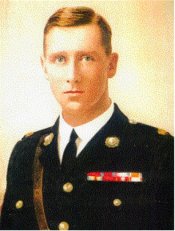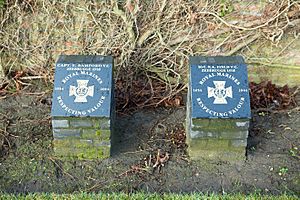Edward Bamford facts for kids
Quick facts for kids
Edward Bamford
|
|
|---|---|
 |
|
| Born | 28 May 1887 Highgate, England |
| Died | 30 September 1928 (aged 41) On board HMS Cumberland, East China Sea |
| Buried |
Shanghai, China
|
| Allegiance | United Kingdom |
| Service/ |
Royal Marines |
| Years of service | 1905–1928 |
| Rank | Major |
| Unit | Royal Marine Light Infantry |
| Battles/wars | First World War
|
| Awards | Victoria Cross Distinguished Service Order Order of Saint Anna, 3rd Class (Russia) Officer of the Legion of Honour (France) Order of the Rising Sun, 4th Class (Japan) |
Edward Bamford, VC, DSO (born May 28, 1887 – died September 30, 1928) was a brave officer in the Royal Marines. He received the Victoria Cross (VC), which is the highest award for bravery given to British and Commonwealth soldiers. He also earned the Distinguished Service Order (DSO) for his courage during the Battle of Jutland.
Early Life and Family
Edward Bamford was born in Highgate, England, on May 28, 1887. His father was a reverend named Robert Bamford. Edward grew up in Sherborne, Dorset.
He went to Sherborne Preparatory School and then Sherborne School. Edward had two brothers. One was Robert Bamford (1883–1942), who helped start the famous car company Aston Martin. His other brother, Arthur Bamford (1889–1915), was a soldier who sadly died during the First World War. Edward also had a sister, Rachel, who served in the Women's Army Auxiliary Corps during the war.
Military Career and Bravery
In September 1905, Edward Bamford joined the Royal Marine Light Infantry. He served on several ships, including HMS Bulwark and HMS Chester.
During the First World War, Edward was a captain. He showed incredible bravery during the Battle of Jutland, a huge naval battle. For his actions there, he was given the Distinguished Service Order.
The Zeebrugge Raid

Captain Bamford earned his Victoria Cross during a very dangerous mission called the Zeebrugge Raid in April 1918. This raid was an attempt to block a German submarine base in Zeebrugge, Belgium.
Edward Bamford led his Marine storming force onto a long pier called the Mole. This was very difficult because they were under heavy enemy fire. He set up a strong defensive position. Then, he bravely led an attack on an enemy battery (a group of cannons). His courage and leadership were an amazing example to his men.
The officers of the Royal Marines involved in the Zeebrugge Raid voted for who they thought deserved the Victoria Cross. Captain Bamford was chosen because of his outstanding bravery.
Besides the Victoria Cross and Distinguished Service Order, Edward Bamford received other awards. These included the Russian Order of Saint Anna, the French Legion of Honour, and the Japanese Order of the Rising Sun. He later became a Major.
Death and Legacy
Major Edward Bamford died on September 30, 1928, from pneumonia. He was on board HMS Cumberland while traveling to Hong Kong. He was buried in Shanghai, China. Sadly, his grave was later destroyed during the Cultural Revolution.
Today, there are memorials to Edward Bamford in Deal and at the Royal Marines Barracks in Eastney. In 2004, the Royal Marines placed a special plaque in his memory in Zeebrugge.
You can see his Victoria Cross on display at the Royal Marines Museum in Southsea, England. Edward Bamford is remembered as one of the great heroes of the Zeebrugge Raid.

